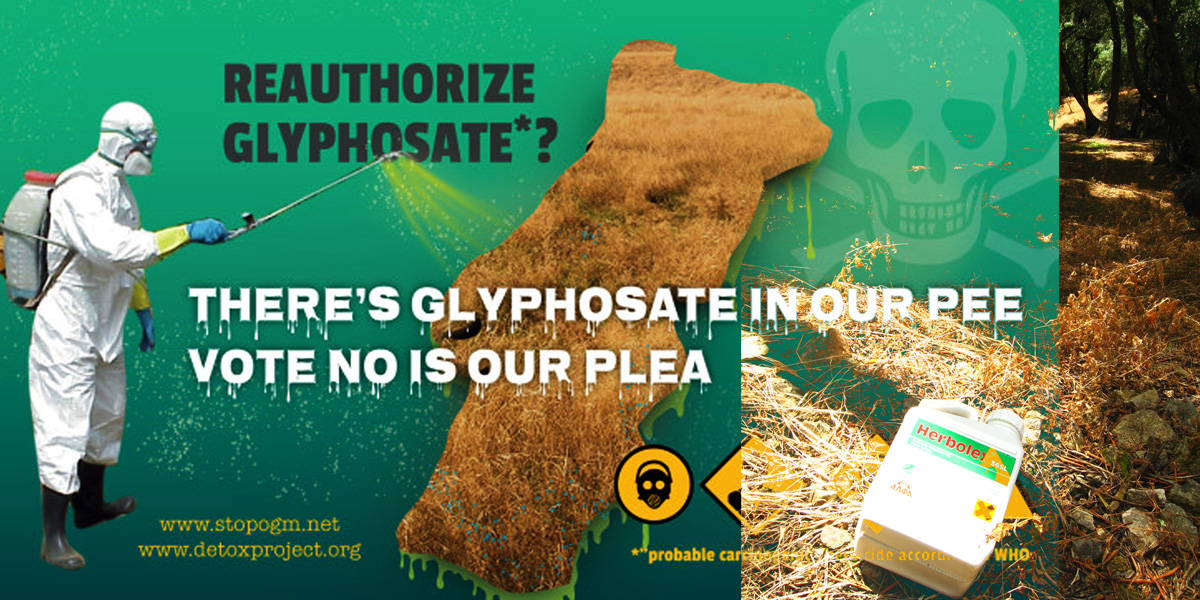
Portugal must “face the problem” and reduce human contamination, says Portuguese No GMO Coalition
Tests carried out by the Portuguese No GMO Coalition in cooperation with the Detox Project have revealed high levels of glyphosate (commonly sold as Roundup) in the urine of Portuguese volunteers, according to a report released by the Coalition.
In 26 volunteers, glyphosate was detected in 100% of the urine samples. By comparison, in Switzerland in 2015, a similar testing programme detected glyphosate in just 38% of cases and in 2013, sampling carried out by Friends of the Earth in 18 European countries showed 44% of the urine samples to be contaminated.
The average value of glyphosate in the urine of the Portuguese samples was 26.2 ng/ml (nanograms per milliliter or parts per billion – ppb).
The limit allowed in drinking water in the EU is 0.1 ng/ml, so the average amount of glyphosate detected in the Portuguese samples is 260 times above the maximum legal limit.
This level is very high compared with previous biosurveys in Europe. The Coalition said: “The scenario in other countries is not perfect, but is much less severe than the Portuguese case.”
For example, in 2013 Friends of the Earth released results of glyphosate testing in urine from 18 EU countries – the highest level found was 1.8 ng/ml in Latvia.
And the Coalition reports that a German study which included more than 2000 people “found an average of just 1.1 ng/ml: approximately 20 times lower than the Portuguese results. The highest value found in Germany was 4.2 ng/ml, while the Portuguese values varied between 12.5 and 32.5 ng/ml. That is, the least contaminated Portuguese volunteer has three times more glyphosate than the worst German case.”
Other findings in Portugal
Other findings of the Portuguese testing programme included:
- the three youngest volunteers (aged between 7 and 19 years old) presented an average value higher (26.7 ng/ml) than the whole group, a disproportion that was also identified in the German study;
- there was no clear difference in the average values of the four volunteers who were professional gardeners, even though they may have been expected to have higher levels (the other 22 were all urban dwellers with no professional exposure);
- the values above 20 ng/ml are, according to the available literature, the highest concentrations ever found in people with no professional exposure to glyphosate.
Food results
Some food samples were also analyzed with the support of the Detox Project, using a US-based laboratory and an LC/MS/MS validated testing method.
The Portuguese No GMO Coalition chose wheat (wholegrain and flour), wholegrain oats and cow’s milk to test, with the following results:
Wholegrain oats: 10 ng/g (ppb)
Wholegrain wheat: 43 ng/g (ppb)
White flour (wheat): 46 ng/g
Cow’s milk: none detected.
Are the levels found dangerous?
No one knows if the levels of glyphosate found could cause endocrine (hormonal) disruption or other health problems, since they have not been directly tested. Only much higher levels have been tested by industry for regulatory purposes and claimed to show no effect.
But science has shown that many toxic chemicals can have a bigger influence on the hormonal system at very low doses, even when higher doses have no such effect. Endocrine disrupting chemicals are believed to be implicated in diseases such as cancer, birth defects, and developmental problems.
Where does the glyphosate come from?
Glyphosate is the most used chemical pesticide in Portugal, with over 1600 tons sold annually, according to the Coalition.
But exactly how and where it is being used remains a mystery.
There are some possible clues that need following up. A report by the European Forum on Nature Conservation and Pastoralism and the Asociación para el Análisis y Reforma de la Política Agro-rural notes that glyphosate is increasingly used to control weeds in intensively managed olive groves – a job that in traditional plantations is done by grazing, mowing, or tillage.
And in vineyards and orchards, glyphosate is being over-used, leading to glyphosate-resistant weeds being recorded.
Urban street spraying will also be a factor.
But none of these uses are unique to Portugal – they also apply to other European countries. So it’s unclear why the levels in the urine of Portuguese people should be so much higher.
The Portuguese No GMO Coalition wants answers to these questions. It says it has been over ten years since any official testing for glyphosate was carried out in food, soil, water, air or people in the country. The Coalition said: “Portugal must now face the problem and find solutions both at the national and European levels in order to clarify the reasons for such high human contamination and reduce it by several orders of magnitude.”
Sources:
Sustainable Pulse
Transgenicos Fora – Portuguese No GMO Coalition press release, 9 May 2016, “Tests made for the first time reveal situation out of control: GLYPHOSATE: THE HERBICIDE CONTAMINATING PORTUGAL”. English; Portuguese










